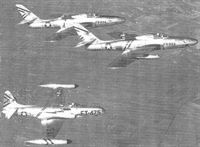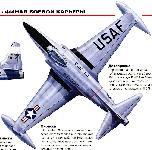
XFP-80A (позже XF-14): единственный опытный экземпляр для фоторазведки
ERF-80A: обозначение одного F-80A, использованного для испытаний фотооборудования
F-14A (затем самолет обозначили FP-80A, позже RF-80A): серийный вариант для фоторазведки, первые 38 самолетов были переделаны из варианта P-80A, а остальные 114 построены заново
RF-80C: новое обозначение 70 самолетов F-80A, переделанных в самолеты-разведчики
- Описание
Фотографии
-
Air Enthusiast 2001-07 / Round-Out
Регистрационный номер: FT-330 [2] Lockheed RF-80A Shooting Star 44-85330 'FT-330' of the 117th Tactical Reconnaissance Wing, 38th Tactical Reconnaissance Squadron, Neubiberg, West Germany, 1953.
-
Мировая Авиация 135
Регистрационный номер: FT-373 RF-80A Shooting Star. RF-80A поступили на вооружение 67-го авиакрыла в 1946 году и несли службу в Корее вместе с обычными F-80. Этот RF-80A из 15-й разведэскадрильи в 1952 году базировался в Кимпо. В начале 1950-х годов RF-80 был основным тактическим разведчиком ВВС США и часто использовался совместно с RF-51 и RB-26.
-
Air Enthusiast 2001-07 / Round-Out
Регистрационный номер: PN-422 Lockheed RF-80A Shooting Star 44-8422 'PN-422' of the 161st Tactical Reconnaissance Squadron, Langley, USA, 1949.
-
Air International 1982-08 / Model enthusiast
Регистрационный номер: FT-467 [2] RF-80A (44-85467) converted from F-80A-5 for photo-recce task. Note retention of fighter category "FT" buzz code.
-
Мировая Авиация 118
Регистрационный номер: FT-467 [2] Разведывательный вариант. RF-80 создавался на базе F-80A, но пулеметы были демонтированы. Самолет стал единственным реактивным тактическим разведчиком ВВС США в начале корейской войны. Данный самолет принадлежал 67-му тактическому разведывательному авиакрылу, дислоцированному в 1950-1953 годах в Сувоне, Корея. Он стал одним из двух самолетов, применявшихся в небе Северной Кореи в рамках операции "Stovepipe" и получивших для этого экспериментальную схему камуфляжа - "хаки и нейтральный серый". Распространения данная схема не получила.
-
Air Enthusiast 2007-07 / D.Gordon - Last of the Best /Post-war combat/ (1)
Регистрационный номер: FT-391 RF-80A 45-8391 flown by 1st Lt Robert H Clark flies in close formation with the cameraman Lt Dick Cathriner. The markings for the RF-80s were changed in 1955 to the scheme illustrated.
-
Air Enthusiast 2003-09 / D.Gordon - Sabres with 'Eyes'
In 1953, at the end of the Korean War, the 67th TRW flew the RB-26, RF-80 and T-33 as well as the RF-86 Sabre. All the wing's aircraft are seen in the company of a Marine recce Banshee.
Другие самолёты на фотографии: Douglas A-26 / B-26 Invader - США - 1942Lockheed T-33A - США - 1948McDonnell F2H Banshee - США - 1947North American RF-86 - США - 1951
-
Air Enthusiast 2007-07 / D.Gordon - Last of the Best /Post-war combat/ (1)
Somewhere over the Rhine in the vicinity of Weisbaden in September 1955 RF-80A 45-8391 flown by 1st Lt. Robert H Clark makes a swift departure.
-
Air Enthusiast 2001-07 / D.Gordon - TAC Recon Masters (1)
Регистрационный номер: FT-412 En route for Germany, RF-80A 45-8412 of the 303rd TRS at Blue West One, Greenland.
-
Air Enthusiast 2007-07 / D.Gordon - Last of the Best /Post-war combat/ (1)
Регистрационный номер: FT-330 [2] RF-80A 44-85330 at 'Spang' in 1954. It was converted to recce configuration from a P-80A; note the distinctive hump in the nose contours
-
Aviation Historian 16 / D.Gordon - Spies in Cold War Skies
Регистрационный номер: FT-417 Lockheed RF-80A 45-8417 of the 8th Tactical Reconnaissance Squadron at Taegu in South Korea during 1950-51. The standard F-80’s radio compass antenna was removed on the RF-80 to make space for a K-18 camera with a 36in lens, which took forward oblique photos through a transparency in the nose.
-
Aviation Historian 10 / D.Gordon - The Polka-Dot Ridge Runners
Регистрационный номер: RF-541 In early 1953 the Polka Dots swapped their Mustangs for Lockheed RF-80s, an occasion that demanded a photo-call, with RF-51D Wind Wraith being posed nose-to-nose with an RF-80 at Kimpo on January 1, 1953.
Другие самолёты на фотографии: North American P-51D Mustang - США - 1944
-
Air Enthusiast 2001-07 / D.Gordon - TAC Recon Masters (1)
Регистрационный номер: FT-425 Captain Bob Sweet with RF-80A 45-8425 at Sembach in 1954. Bob Sweet was a veteran of Korea where he flew T-6s, Mustangs and the RF-80A. After the RF-80 he went on the fly the RF-84 and the RF-101C.
-
Air Enthusiast 2001-07 / D.Gordon - TAC Recon Masters (1)
Регистрационный номер: FT-365 The maintenance team poses briefly for a snap while working on RF-80A 45-8365.
-
Air Enthusiast 2001-07 / D.Gordon - TAC Recon Masters (1)
Регистрационный номер: FT-325 RF-80A, 45-8325 at Shaw AFB prior to the departure for Germany, July 1953. Note the luggage in the camera bay.
-
Aeroplane Monthly 1996-08 / D.Gordon - Fading stars over Europe
Регистрационный номер: PN-491 FP-80A-5-LO 48-5491 of the 363rd Reconnaissance Group about to touch down in the USA. The FP-80A-LO was the production version of the Shooting Star reconnaisance aircraft.
-
Aeroplane Monthly 1996-08 / D.Gordon - Fading stars over Europe
Регистрационный номер: PN-314 Chequer-tailed FP-80A-5-LO 45-8314 of the 363rd Reconnaisance Group, based at Langley, Virginia.
-
Мировая Авиация 130
Регистрационный номер: PN-465 RF-80A (F-14A, FP-80A). Были построены 152 разведывательных RF-80A - 38 переоборудовали из P-80A, а 114 - построили заново. Вначале самолеты оснащались ТРД J33-GE-11 или J-33-A-9, но затем на машины стали устанавливаться ТРД J-33-A-17, а часть машин была оборудована еще и ускорителями RATO, одновременно с радиокомпасами. RF-80A несли один аэрофотоаппарат K-17 (фокусное расстояние 152,4 мм) и два аэрофотоаппарата K-22 (фокусное расстояние 609 мм).
The Lockheed FP-80A Shooting Star, the Photographic-Reconnaissance version of the P-80A Fighter. -
Мировая Авиация 118
RF-80 - серийная модификация разведывательного Shooting Star: 38 самолетов были изначально заложены на стапеле как P-80A, а еще 114 - построены "с нуля". Позже 66 RF-80A были переоборудованы из F-80A. На фотографии - один из самолетов, переоборудованных из P-80A еще на стапеле (их можно идентифицировать по контуру носовой части фюзеляжа - в виде "лесенки"). Самолет принадлежал 160-й тактической разведывательной эскадрилье авиации Национальной гвардии штата Алабама
-
Air International 1994-08 / R.Dorr - Lockheed F-80. A Star is Born
The seventh P-80A 44-84998, was converted to F-14A reconnaissance configuration, with cameras in the extended nose. The type was successively redesignated FP-80A and then RF-80A.
-
Jane's All the World Aircraft 1980 / Encyclopedia of Aviation - Aircraft A-Z - v4
Checking the cameras in a Lockheed RF-80 Shooting Star.
-
Air Enthusiast 2001-07 / D.Gordon - TAC Recon Masters (1)
Регистрационный номер: FT-168 Preparing RF-80A 44-85168 of the 303rd TRS for flight, 1954.
-
Aeroplane Monthly 1996-08 / D.Gordon - Fading stars over Europe
Регистрационный номер: FT-408 [2] A close-up of RF-80A-LO 45-8408, showing the array of camera equipment carried in the nose.
-
Aeroplane Monthly 1996-08 / D.Gordon - Fading stars over Europe
Регистрационный номер: FT-408 [2] RF-80A 45-8408 of the 302nd Tactical Reconnaissance Squadron, 66th Tactical Reconnaissance Wing, at Hahn in 1955.
-
Air Enthusiast 2001-07 / D.Gordon - TAC Recon Masters (1)
Регистрационный номер: FT-302 Arrival at Sembach, July 19, 1953, 303rd TRS commander Jean K Woodyard with RF-80A 45-8302. Colonel Rose is on the right talking to Woodyard.
-
Air Enthusiast 2001-07 / D.Gordon - TAC Recon Masters (1)
Регистрационный номер: FT-244 1st Lt James R Tansey poses at Sembach with his speed machines, 1955.
-
Aeroplane Monthly 1996-08 / D.Gordon - Fading stars over Europe
Регистрационный номер: FT-399 RF-80A 45-8399 of the 38th Tactical Reconnaissance Squadron, 10th Tactical Reconnaissance Wing, at Bovingdon in October 1955, where it had crash-landed when its nosewheel collapsed.
-
Air Enthusiast 2007-07 / D.Gordon - Last of the Best /Post-war combat/ (1)
Регистрационный номер: FT-463 [2] 2nd Lt Ken Brumbeloe climbs aboard RF-80A 45-8463 under an overcast and wet sky at Spangdahlem in autumn 1954.
-
Air Enthusiast 2007-07 / D.Gordon - Last of the Best /Post-war combat/ (1)
2nd Lt Grayson Powell perched on his RF-80A at Spangdahlem in 1954.
-
Air Enthusiast 2001-07 / D.Gordon - TAC Recon Masters (1)
Регистрационный номер: FT-242 RF-80A 4485242 of the 303rd in company with RF-84F 51-1933 at Sembach in 1955. This was the second RF-84F to be assigned to the squadron.
Другие самолёты на фотографии: Republic RF-84F Thunderflash - США - 1952
-
Aviation Historian 16 / D.Gordon - Spies in Cold War Skies
Регистрационный номер: FT-443 A very heavily-laden RF-80 uses rocket-assisted take-off (RATO) equipment to get off at Yokota. The large underslung “Misawa" extra-long-range tiptanks were made at Yokota using standard F-80 165 US gal tiptanks with two additional sections inserted in the middle, each reportedly capable of holding some 265 US gal.
-
Air Enthusiast 2001-07 / D.Gordon - TAC Recon Masters (1)
Регистрационный номер: FT-310 RF-80A, 45-8310, en route to Sidi Slimane, Morocco, over the Atlas Mountains
-
Air Enthusiast 2007-07 / D.Gordon - Last of the Best /Post-war combat/ (1)
A lone RF-80A flies over Spangdahlem in spring 1954.
-
Air Enthusiast 2001-07 / D.Gordon - TAC Recon Masters (1)
Регистрационный номер: FT-172 [2], FT-437 [2], FT-448 Three of the 'Bald Iggles' of the 302nd TRS over Luneville, France, 1955. There were four members of the team but photos were invariably taken by the slot man, Russ Tansey
-
Aeroplane Monthly 1996-08 / D.Gordon - Fading stars over Europe
Регистрационный номер: FT-387 [2], FT-394, FT-460, FT-463 [2] A quartet of RF-80As of the 10th Tactical Reconnaissance Wing in formation during 1953.
-
Air Enthusiast 2007-07 / D.Gordon - Last of the Best /Post-war combat/ (1)
Four RF-80s of the 160th TRS, 117th TRW fly over the German landscape.
-
Air Enthusiast 2001-07 / D.Gordon - TAC Recon Masters (1)
Регистрационный номер: FT-172 [2], FT-437 [2] The 'Bald Iggles' acrobatic team near Toul-Rosiere, France, in the spring of 1955.
-
Air Enthusiast 2001-07 / D.Gordon - TAC Recon Masters (1)
Регистрационный номер: FT-475 [2] RF-80A 45-8475 keeps company with the first two RF-84Fs delivered to the 303rd TRS, 51-1933 and 51-1894.
Другие самолёты на фотографии: Republic RF-84F Thunderflash - США - 1952
-
Air Enthusiast 2007-07 / D.Gordon - Last of the Best /Post-war combat/ (1)
Регистрационный номер: FT-387 [2] An RF-80A in company with its stablemate at Spangadahlem, an RB-26 of the 1st TRS, 10th TRW.
Другие самолёты на фотографии: Douglas A-26 / B-26 Invader - США - 1942
-
Авиация и Время 2009-01 / А.Чечин, Н.Околелов - "Летающие крылья" Нортропа (2)
Для сопровождения YB-49 в испытательных полетах использовались реактивные истребители, летчики которых отмечали, что YB-49 отличается великолепной маневренностью. В данном случае YB-49 сопровождает разведчик RF-80
Другие самолёты на фотографии: Northrop B-49 - США - 1947
-
Air Enthusiast 2001-07 / D.Gordon - TAC Recon Masters (1)
Регистрационный номер: FT-475 [2] RF-80A 45-8475 undergoing field maintenance during an exercise in Germany.
-
Air Enthusiast 2007-07 / D.Gordon - Last of the Best /Post-war combat/ (1)
Регистрационный номер: FT-462 Two RF-80s after an unfortunate collision on the ground. One aircraft jumped its chocks and collided with others
-
Мировая Авиация 130
F-14. Обозначение прототипа варианта PR самолета P-80. Единственный самолет был заказан как один из YP-80A и вместо пулеметов оснащался фотокамерами. В отличие от последующих разведывательных модификаций на этом самолете окон для фотокамер по бокам носовой части не было. 6 декабря 1944 года F-14 был потерян в результате столкновения в воздухе с самолетом B-25.
-
Мировая Авиация 130
RF-80C. В годы корейской войны 70 самолетов F-80A/C были переоборудованы в вариант RF-80C, который отличался от других разведывательных модификаций ровным носовым обтекателем (как у истребителя). Пулеметы были заменены одним или двумя аэрофотоаппаратами K-14, но краской на фюзеляже были нарисованы пулеметные порты для обмана противника. Еще шесть RF-80A были модифицированы "Lockheed" в RF-80C-11-LO (на схеме), самолеты получили двигатели J33-A-35, катапультное кресло и возможность установки радиостанции AN/ARC-27.
-
Air International 1994-08 / R.Dorr - Lockheed F-80. A Star is Born
The general arrangement drawings depict: A - the XP-80 as first flown; B - the P-80C (side plan and head-on view); C - scrap view of the original wing tip tanks; D - scrap view of the later Fletcher-type tip tanks; E - the RF-80.
Другие самолёты на фотографии: Lockheed P-80 Shooting Star - США - 1944
- Фотографии














































